DNA Catalysis: Design, Function, and Optimization
Abstract
1. Introduction
2. DNA-Dominant Catalysts
3. DNA–Nanoparticle Hybrid

4. DNA–Carbon Hybrids
5. DNA–Soft Matter Catalysts
6. Conclusions
Funding
Institutional Review Board Statement
Informed Consent Statement
Data Availability Statement
Acknowledgments
Conflicts of Interest
References
- Montserrat Pagès, A.; Hertog, M.; Nicolaï, B.; Spasic, D.; Lammertyn, J. Unraveling the Kinetics of the 10–23 RNA-Cleaving DNAzyme. Int. J. Mol. Sci. 2023, 24, 13686. [Google Scholar] [CrossRef] [PubMed]
- Bi, S.; Yan, Y.; Hao, S.; Zhang, S. Colorimetric Logic Gates Based on Supramolecular DNAzyme Structures. Angew. Chem. Int. Ed. 2010, 49, 4438–4442. [Google Scholar] [CrossRef] [PubMed]
- Woese, C.R.; Dugre, D.H.; Saxinger, W.C.; Dugre, S.A. The molecular basis for the genetic code. Proc. Natl. Acad. Sci. USA 1966, 55, 966–974. [Google Scholar] [CrossRef]
- Kruger, K.; Grabowski, P.J.; Zaug, A.J.; Sands, J.; Gottschling, D.E.; Cech, T.R. Self-splicing RNA: Autoexcision and autocyclization of the ribosomal RNA intervening sequence of tetrahymena. Cell 1982, 31, 147–157. [Google Scholar] [CrossRef]
- Shampo, M.A.; Kyle, R.A.; Steensma, D.P. Sidney Altman—Nobel laureate for work with RNA. Mayo Clin. Proc. 2012, 87, e73. [Google Scholar] [CrossRef]
- Santoro, S.W.; Joyce, G.F. A general purpose RNA-cleaving DNA enzyme. Proc. Natl. Acad. Sci. USA 1997, 94, 4262–4266. [Google Scholar] [CrossRef]
- Joyce, G.F. In vitro evolution of nucleic acids. Curr. Opin. Struct. Biol. 1994, 4, 331–336. [Google Scholar] [CrossRef]
- Breaker, R.R.; Joyce, G.F. Inventing and improving ribozyme function: Rational design versus iterative selection methods. Trends Biotechnol. 1994, 12, 268–275. [Google Scholar] [CrossRef] [PubMed]
- Chapman, K.B.; Szostak, J.W. In vitro selection of catalytic RNAs. Curr. Opin. Struct. Biol. 1994, 4, 618–622. [Google Scholar] [CrossRef]
- Jaeger, L.; Michel, F.; Westhof, E. The Structure of Group I Ribozymes. In Catalytic RNA; Eckstein, F., Lilley, D.M.J., Eds.; Springer: Berlin/Heidelberg, Germany, 1997; pp. 33–51. [Google Scholar] [CrossRef]
- Pyle, A.M. Ribozymes: A distinct class of metalloenzymes. Science 1993, 261, 709–714. [Google Scholar] [CrossRef]
- Symons, R.H. Ribozymes. Curr. Opin. Struct. Biol. 1994, 4, 322–330. [Google Scholar] [CrossRef]
- Inomata, R.; Zhao, J.; Miyagishi, M. Zn2+-dependent DNAzymes that cleave all combinations of ribonucleotides. Commun. Biol. 2021, 4, 221. [Google Scholar] [CrossRef] [PubMed]
- Xiao, L.; Zhao, Y.; Yang, M.; Luan, G.; Du, T.; Deng, S.; Jia, X. A promising nucleic acid therapy drug: DNAzymes and its delivery system. Front. Mol. Biosci. 2023, 10, 1270101. [Google Scholar] [CrossRef] [PubMed]
- Ma, X.; Ding, W.; Wang, C.; Wu, H.; Tian, X.; Lyu, M.; Wang, S. DNAzyme biosensors for the detection of pathogenic bacteria. Sens. Actuators B Chem. 2021, 331, 129422. [Google Scholar] [CrossRef]
- Zhou, W.; Ding, J.; Liu, J. Theranostic DNAzymes. Theranostics 2017, 7, 1010–1025. [Google Scholar] [CrossRef]
- Hagerman, P.J. Flexibility of DNA. Annu. Rev. Biophys. 1988, 17, 265–286. [Google Scholar] [CrossRef]
- Bao, L.; Zhang, X.; Jin, L.; Tan, Z.-J. Flexibility of nucleic acids: From DNA to RNA*. Chin. Phys. B 2016, 25, 018703. [Google Scholar] [CrossRef]
- Smith, S.B.; Cui, Y.; Bustamante, C. Overstretching B-DNA: The elastic response of individual double-stranded and single-stranded DNA molecules. Science 1996, 271, 795–799. [Google Scholar] [CrossRef]
- Chandra, M.; Silverman, S.K. DNA and RNA Can Be Equally Efficient Catalysts for Carbon–Carbon Bond Formation. J. Am. Chem. Soc. 2008, 130, 2936–2937. [Google Scholar] [CrossRef]
- Breaker, R.R.; Joyce, G.F. A DNA enzyme that cleaves RNA. Chem. Biol. 1994, 1, 223–229. [Google Scholar] [CrossRef]
- Rosenbach, H.; Victor, J.; Etzkorn, M.; Steger, G.; Riesner, D.; Span, I. Molecular Features and Metal Ions That Influence 10–23 DNAzyme Activity. Molecules 2020, 25, 3100. [Google Scholar] [CrossRef] [PubMed]
- Ponce-Salvatierra, A.; Boccaletto, P.; Bujnicki, J.M. DNAmoreDB, a database of DNAzymes. Nucleic Acids Res. 2021, 49, D76–D81. [Google Scholar] [CrossRef] [PubMed]
- Gao, L.; Yi, K.; Tan, Y.; Guo, C.; Zheng, D.; Shen, C.; Li, F. Engineering Gene-Specific DNAzymes for Accessible and Multiplexed Nucleic Acid Testing. JACS Au 2024, 4, 1664–1672. [Google Scholar] [CrossRef]
- Carmi, N.; Shultz, L.A.; Breaker, R.R. In vitro selection of self-cleaving DNAs. Chem. Biol. 1996, 3, 1039–1046. [Google Scholar] [CrossRef] [PubMed]
- Carmi, N.; Balkhi, S.R.; Breaker, R.R. Cleaving dna with dna. Proc. Natl. Acad. Sci. USA 1998, 95, 2233–2237. [Google Scholar] [CrossRef]
- Cuenoud, B.; Szostak, J.W. A DNA metalloenzyme with DNA ligase activity. Nature 1995, 375, 611–614. [Google Scholar] [CrossRef]
- Levy, M.; Ellington, A.D. Selection of deoxyribozyme ligases that catalyze the formation of an unnatural internucleotide linkage. Bioorganic Med. Chem. 2001, 9, 2581–2587. [Google Scholar] [CrossRef] [PubMed]
- Sreedhara, A.; Li, Y.; Breaker, R.R. Ligating DNA with DNA. J. Am. Chem. Soc. 2004, 126, 3454–3460. [Google Scholar] [CrossRef]
- Li, Y.; Breaker, R.R. Phosphorylating DNA with DNA. Proc. Natl. Acad. Sci. USA 1999, 96, 2746–2751. [Google Scholar] [CrossRef]
- Wang, W.; Billen, L.P.; Li, Y. Sequence diversity, metal specificity, and catalytic proficiency of metal-dependent phosphorylating DNA enzymes. Chem. Biol. 2002, 9, 507–517. [Google Scholar] [CrossRef]
- Velez, T.E.; Singh, J.; Xiao, Y.; Allen, E.C.; Wong, O.Y.; Chandra, M.; Kwon, S.C.; Silverman, S.K. Systematic evaluation of the dependence of deoxyribozyme catalysis on random region length. ACS Comb. Sci. 2012, 14, 680–687. [Google Scholar] [CrossRef] [PubMed]
- Kennebeck, M.M.; Kaminsky, C.K.; Massa, M.A.; Das, P.K.; Boyd, R.D.; Bishka, M.; Tricarico, J.T.; Silverman, S.K. DNAzyme-Catalyzed Site-Specific N-Acylation of DNA Oligonucleotide Nucleobases. Angew. Chem. Int. Ed. 2024, 63, e202317565. [Google Scholar] [CrossRef] [PubMed]
- Breaker, R.R.; Joyce, G.F. A DNA enzyme with Mg2+-dependent RNA phosphoesterase activity. Chem. Biol. 1995, 2, 655–660. [Google Scholar] [CrossRef] [PubMed]
- Brandsen, B.M.; Hesser, A.R.; Castner, M.A.; Chandra, M.; Silverman, S.K. DNA-catalyzed hydrolysis of esters and aromatic amides. J. Am. Chem. Soc. 2013, 135, 16014–16017. [Google Scholar] [CrossRef]
- Yum, J.H.; Kumagai, T.; Hori, D.; Sugiyama, H.; Park, S. Histidine–DNA nanoarchitecture as laccase mimetic DNAzymes. Nanoscale 2023, 15, 10749–10754. [Google Scholar] [CrossRef]
- Gao, L.; Tian, R.; Shao, Y. Photocatalytic Duplex-Based DNAzymes Switched by an Abasic Site. Chemistry 2023, 5, 1497–1507. [Google Scholar] [CrossRef]
- Kamiya, Y.; Arimura, Y.; Ooi, H.; Kato, K.; Liang, X.-G.; Asanuma, H. Development of Visible-Light-Responsive RNA Scissors Based on a 10–23 DNAzyme. ChemBioChem 2018, 19, 1305–1311. [Google Scholar] [CrossRef]
- Faraji, S.; Dreuw, A. Physicochemical Mechanism of Light-Driven DNA Repair by (6-4) Photolyases. Annu. Rev. Phys. Chem. 2014, 65, 275–292. [Google Scholar] [CrossRef]
- Chandrasekar, J.; Wylder, A.C.; Silverman, S.K. Phosphoserine lyase deoxyribozymes: DNA-catalyzed formation of dehydroalanine residues in peptides. J. Am. Chem. Soc. 2015, 137, 9575–9578. [Google Scholar] [CrossRef]
- Chandrasekar, J.; Silverman, S.K. Catalytic DNA with phosphatase activity. Proc. Natl. Acad. Sci. USA 2013, 110, 5315–5320. [Google Scholar] [CrossRef]
- Walsh, S.M.; Sachdeva, A.; Silverman, S.K. DNA catalysts with tyrosine kinase activity. J. Am. Chem. Soc. 2013, 135, 14928–14931. [Google Scholar] [CrossRef] [PubMed]
- Sachdeva, A.; Chandra, M.; Chandrasekar, J.; Silverman, S.K. Covalent Tagging of Phosphorylated Peptides by Phosphate-Specific Deoxyribozymes. ChemBioChem 2012, 13, 654–657. [Google Scholar] [CrossRef]
- Li, Y.; Sen, D. A catalytic DNA for porphyrin metallation. Nat. Struct. Biol. 1996, 3, 743–747. [Google Scholar] [CrossRef] [PubMed]
- Li, Y.; Geyer, R.; Sen, D. Recognition of anionic porphyrins by DNA aptamers. Biochemistry 1996, 35, 6911–6922. [Google Scholar] [CrossRef]
- Li, Y.; Sen, D. Toward an efficient DNAzyme. Biochemistry 1997, 36, 5589–5599. [Google Scholar] [CrossRef] [PubMed]
- Kosman, J.; Juskowiak, B. Peroxidase-mimicking DNAzymes for biosensing applications: A review. Anal. Chim. Acta 2011, 707, 7–17. [Google Scholar] [CrossRef]
- Stefan, L.; Denat, F.; Monchaud, D. Insights into how nucleotide supplements enhance the peroxidase-mimicking DNAzyme activity of the G-quadruplex/hemin system. Nucleic Acids Res. 2012, 40, 8759–8772. [Google Scholar] [CrossRef]
- Pradeepkumar, P.I.; Höbartner, C.; Baum, D.A.; Silverman, S.K. DNA-Catalyzed Formation of Nucleopeptide Linkages. Angew. Chem. Int. Ed. 2008, 47, 1753–1757. [Google Scholar] [CrossRef]
- Sachdeva, A.; Silverman, S.K. DNA-catalyzed serine side chain reactivity and selectivity. Chem. Commun. 2010, 46, 2215–2217. [Google Scholar] [CrossRef]
- Silverman, S.K. Pursuing DNA catalysts for protein modification. Acc. Chem. Res. 2015, 48, 1369–1379. [Google Scholar] [CrossRef]
- Chinnapen, D.J.-F.; Sen, D. A deoxyribozyme that harnesses light to repair thymine dimers in DNA. Proc. Natl. Acad. Sci. USA 2004, 101, 65–69. [Google Scholar] [CrossRef] [PubMed]
- Yao, T.; Przybyla, J.J.; Yeh, P.; Woodard, A.M.; Nilsson, H.J.; Brandsen, B.M.; Silverman, S.K. DNAzymes for amine and peptide lysine acylation. Org. Biomol. Chem. 2021, 19, 171–181. [Google Scholar] [CrossRef] [PubMed]
- Köhler, T.; Patsis, P.A.; Hahn, D.; Ruland, A.; Naas, C.; Müller, M.; Thiele, J. DNAzymes as Catalysts for l-Tyrosine and Amyloid β Oxidation. ACS Omega 2020, 5, 7059–7064. [Google Scholar] [CrossRef]
- Yang, S.; Silverman, S.K. Defining the substrate scope of DNAzyme catalysis for reductive amination with aliphatic amines. Org. Biomol. Chem. 2023, 21, 1910–1919. [Google Scholar] [CrossRef]
- Chen, K.; He, Z.; Xiong, W.; Wang, C.-J.; Zhou, X. Enantioselective Diels–Alder reactions with left-handed G-quadruplex DNA-based catalysts. Chin. Chem. Lett. 2021, 32, 1701–1704. [Google Scholar] [CrossRef]
- Boersma, A.J.; Feringa, B.L.; Roelfes, G. Enantioselective Friedel–Crafts Reactions in Water Using a DNA-Based Catalyst. Angew. Chem. Int. Ed. 2009, 48, 3346–3348. [Google Scholar] [CrossRef]
- Guo, J.; Wang, D.; Pantatosaki, E.; Kuang, H.; Papadopoulos, G.K.; Tsapatsis, M.; Kokkoli, E. A localized enantioselective catalytic site on short DNA sequences and their amphiphiles. JACS Au 2022, 2, 483–491. [Google Scholar] [CrossRef] [PubMed]
- Kurapati, R.; Bianco, A. Peroxidase mimicking DNAzymes degrade graphene oxide. Nanoscale 2018, 10, 19316–19321. [Google Scholar] [CrossRef] [PubMed]
- Liu, H.; Li, G.; Wang, Y.-W.; Zhang, S.; Tang, Z. Bioinspired Catalysis: Self-Assembly of a Protein and DNA as a Catalyst for the Aldol Reaction in Aqueous Media. Synlett 2018, 29, 560–565. [Google Scholar] [CrossRef]
- Hollenstein, M. DNA catalysis: The chemical repertoire of DNAzymes. Molecules 2015, 20, 20777–20804. [Google Scholar] [CrossRef]
- Zuo, L.; Ren, K.; Guo, X.; Pokhrel, P.; Pokhrel, B.; Hossain, M.A.; Chen, Z.-X.; Mao, H.; Shen, H. Amalgamation of DNAzymes and Nanozymes in a Coronazyme. J. Am. Chem. Soc. 2023, 145, 5750–5758. [Google Scholar] [CrossRef] [PubMed]
- Ellington, A.D.; Szostak, J.W. In vitro selection of RNA molecules that bind specific ligands. Nature 1990, 346, 818–822. [Google Scholar] [CrossRef]
- Tuerk, C.; Gold, L. Systematic evolution of ligands by exponential enrichment: RNA ligands to bacteriophage T4 DNA polymerase. Science 1990, 249, 505–510. [Google Scholar] [CrossRef] [PubMed]
- Wilson, D.S.; Szostak, J.W. In vitro selection of functional nucleic acids. Annu. Rev. Biochem. 1999, 68, 611–647. [Google Scholar] [CrossRef] [PubMed]
- Joyce, G.F. Directed evolution of nucleic acid enzymes. Annu. Rev. Biochem. 2004, 73, 791–836. [Google Scholar] [CrossRef]
- Silverman, S.K. Catalytic DNA: Scope, applications, and biochemistry of deoxyribozymes. Trends Biochem. Sci. 2016, 41, 595–609. [Google Scholar] [CrossRef]
- Silverman, S.K. Deoxyribozymes: Selection design and serendipity in the development of DNA catalysts. Acc. Chem. Res. 2009, 42, 1521–1531. [Google Scholar] [CrossRef]
- Keefe, A.D.; Szostak, J.W. Functional proteins from a random-sequence library. Nature 2001, 410, 715–718. [Google Scholar] [CrossRef]
- Kiss, G.; Çelebi-Ölçüm, N.; Moretti, R.; Baker, D.; Houk, K. Computational enzyme design. Angew. Chem. Int. Ed. 2013, 52, 5700–5725. [Google Scholar] [CrossRef]
- Renata, H.; Wang, Z.J.; Arnold, F.H. Expanding the enzyme universe: Accessing non-natural reactions by mechanism-guided directed evolution. Angew. Chem. Int. Ed. 2015, 54, 3351–3367. [Google Scholar] [CrossRef]
- Schlosser, K.; Li, Y. Tracing sequence diversity change of RNA-cleaving deoxyribozymes under increasing selection pressure during in vitro selection. Biochemistry 2004, 43, 9695–9707. [Google Scholar] [CrossRef]
- Peracchi, A. DNA catalysis: Potential, limitations, open questions. ChemBioChem 2005, 6, 1316–1322. [Google Scholar] [CrossRef] [PubMed]
- Du, X.; Zhong, X.; Li, W.; Li, H.; Gu, H. Retraining and optimizing DNA-hydrolyzing deoxyribozymes for robust single-and multiple-turnover activities. ACS Catal. 2018, 8, 5996–6005. [Google Scholar] [CrossRef]
- Streckerová, T.; Kurfürst, J.; Curtis, E.A. Single-round deoxyribozyme discovery. Nucleic Acids Res. 2021, 49, 6971–6981. [Google Scholar] [CrossRef] [PubMed]
- Zhou, P.; Jia, S.; Pan, D.; Wang, L.; Gao, J.; Lu, J.; Shi, J.; Tang, Z.; Liu, H. Reversible regulation of catalytic activity of gold nanoparticles with DNA nanomachines. Sci. Rep. 2015, 5, 14402. [Google Scholar] [CrossRef]
- Zeng, C.; Lu, N.; Wen, Y.; Liu, G.; Zhang, R.; Zhang, J.; Wang, F.; Liu, X.; Li, Q.; Tang, Z.; et al. Engineering Nanozymes Using DNA for Catalytic Regulation. ACS Appl. Mater. Interfaces 2019, 11, 1790–1799. [Google Scholar] [CrossRef]
- Hizir, M.S.; Top, M.; Balcioglu, M.; Rana, M.; Robertson, N.M.; Shen, F.; Sheng, J.; Yigit, M.V. Multiplexed activity of perAuxidase: DNA-capped AuNPs act as adjustable peroxidase. Anal. Chem. 2016, 88, 600–605. [Google Scholar] [CrossRef] [PubMed]
- Wang, X.; Xu, Y.; Cheng, N.; Zhang, Q.; Yang, Z.; Liu, B.; Wang, X.; Huang, K.; Luo, Y. Pd@Pt nanoparticles: Trienzyme catalytic mechanisms, surface-interface effect with DNA and application in biosensing. Sens. Actuators B Chem. 2022, 364, 131907. [Google Scholar] [CrossRef]
- Fu, Y.; Zhao, X.; Zhang, J.; Li, W. DNA-based platinum nanozymes for peroxidase mimetics. J. Phys. Chem. C 2014, 118, 18116–18125. [Google Scholar] [CrossRef]
- Reena, V.N.; Bhagyasree, G.S.; Shilpa, T.; Aswati Nair, R.; Nithyaja, B. Multifaceted Applications of DNA-Capped Silver Nanoparticles in Photonics, Photocatalysis, Antibacterial Activity, Cytotoxicity, and Bioimaging. J. Fluoresc. 2024, 1–15. [Google Scholar] [CrossRef]
- Liu, B.; Liu, J. Accelerating peroxidase mimicking nanozymes using DNA. Nanoscale 2015, 7, 13831–13835. [Google Scholar] [CrossRef] [PubMed]
- Zhang, X.; Wang, F.; Liu, B.; Kelly, E.Y.; Servos, M.R.; Liu, J. Adsorption of DNA Oligonucleotides by Titanium Dioxide Nanoparticles. Langmuir 2014, 30, 839–845. [Google Scholar] [CrossRef] [PubMed]
- Tiwari, J.N.; Nath, K.; Kumar, S.; Tiwari, R.N.; Kemp, K.C.; Le, N.H.; Youn, D.H.; Lee, J.S.; Kim, K.S. Stable platinum nanoclusters on genomic DNA–graphene oxide with a high oxygen reduction reaction activity. Nat. Commun. 2013, 4, 2221. [Google Scholar] [CrossRef] [PubMed]
- Baker, S.E.; Cai, W.; Lasseter, T.L.; Weidkamp, K.P.; Hamers, R.J. Covalently Bonded Adducts of Deoxyribonucleic Acid (DNA) Oligonucleotides with Single-Wall Carbon Nanotubes: Synthesis and Hybridization. Nano Lett. 2002, 2, 1413–1417. [Google Scholar] [CrossRef]
- Sun, H.; Ren, J.; Qu, X. Carbon nanomaterials and DNA: From molecular recognition to applications. Acc. Chem. Res. 2016, 49, 461–470. [Google Scholar] [CrossRef]
- Shin, S.R.; Jin, K.S.; Lee, C.K.; Kim, S.I.; Spinks, G.M.; So, I.; Jeon, J.-H.; Kang, T.M.; Mun, J.Y.; Han, S.-S.; et al. Fullerene Attachment Enhances Performance of a DNA Nanomachine. Adv. Mater. 2009, 21, 1907–1910. [Google Scholar] [CrossRef]
- Zuo, L.; Hossain, M.A.; Dubadi, R.; Kist, M.M.; Farhana, F.; Chen, J.; Jaroniec, M.; Shen, H. Fluorogenic Reaction Probes Defect Sites on Titanium Dioxide Nanoparticles. ChemNanoMat 2024, 10, e202400031. [Google Scholar] [CrossRef]
- Zuo, L.; King, H.; Hossain, M.A.; Farhana, F.; Kist, M.M.; Stratton, R.L.; Chen, J.; Shen, H. Single-Molecule Spectroscopy Reveals the Plasmon-Assisted Nanozyme Catalysis on AuNR@TiO2. Chem. Biomed. Imaging 2023, 1, 760–766. [Google Scholar] [CrossRef]
- Zuo, L.; Hossain, M.A.; Pokhrel, B.; Chang, W.-S.; Shen, H. Catalysis driven by biohybrid nanozyme. Adv. Sens. Energy Mater. 2022, 1, 100024. [Google Scholar] [CrossRef]
- Huang, Y.; Ren, J.; Qu, X. Nanozymes: Classification, catalytic mechanisms, activity regulation, and applications. Chem. Rev. 2019, 119, 4357–4412. [Google Scholar] [CrossRef]
- Turriani, E.; Höbartner, C.; Jovin, T.M. Mg2+-dependent conformational changes and product release during DNA-catalyzed RNA ligation monitored by Bimane fluorescence. Nucleic Acids Res. 2015, 43, 40–50. [Google Scholar] [CrossRef] [PubMed]
- Lam, J.C.; Li, Y. Influence of Cleavage Site on Global Folding of an RNA-Cleaving DNAzyme. ChemBioChem 2010, 11, 1710–1719. [Google Scholar] [CrossRef] [PubMed]
- McManus, S.A.; Li, Y. The structural diversity of deoxyribozymes. Molecules 2010, 15, 6269–6284. [Google Scholar] [CrossRef] [PubMed]
- Cheng, M.; Zhou, J.; Jia, G.; Ai, X.; Mergny, J.-L.; Li, C. Relations between the loop transposition of DNA G-quadruplex and the catalytic function of DNAzyme. Biochim. Biophys. Acta BBA-Gen. Subj. 2017, 1861, 1913–1920. [Google Scholar] [CrossRef] [PubMed]
- Kim, K.-S.; Choi, W.-H.; Gong, S.-J.; Oh, S.-T.; Kim, J.-H.; Kim, D.-E. Efficient target site selection for an RNA-cleaving DNAzyme through combinatorial library screening. Bull. Korean Chem. Soc. 2006, 27, 657–662. [Google Scholar]
- Ota, N.; Warashina, M.; Hirano, K.i.; Hatanaka, K.; Taira, K. Effects of helical structures formed by the binding arms of DNAzymes and their substrates on catalytic activity. Nucleic Acids Res. 1998, 26, 3385–3391. [Google Scholar] [CrossRef]
- Nguyen, K.; Malik, T.N.; Chaput, J.C. Chemical evolution of an autonomous DNAzyme with allele-specific gene silencing activity. Nat. Commun. 2023, 14, 2413. [Google Scholar] [CrossRef]
- Borggräfe, J.; Victor, J.; Rosenbach, H.; Viegas, A.; Gertzen, C.G.; Wuebben, C.; Kovacs, H.; Gopalswamy, M.; Riesner, D.; Steger, G. Time-resolved structural analysis of an RNA-cleaving DNA catalyst. Nature 2022, 601, 144–149. [Google Scholar] [CrossRef]
- Parra-Meneses, V.; Rojas-Hernández, F.; Cepeda-Plaza, M. The role of Na+ in catalysis by the 8–17 DNAzyme. Org. Biomol. Chem. 2022, 20, 6356–6362. [Google Scholar] [CrossRef]
- Ward, W.L.; Plakos, K.; DeRose, V.J. Nucleic acid catalysis: Metals, nucleobases, and other cofactors. Chem. Rev. 2014, 114, 4318–4342. [Google Scholar] [CrossRef]
- Javadi-Zarnaghi, F.; Höbartner, C. Lanthanide cofactors accelerate DNA-catalyzed synthesis of branched RNA. J. Am. Chem. Soc. 2013, 135, 12839–12848. [Google Scholar] [CrossRef] [PubMed]
- Li, Y.; Zandieh, M.; Liu, J. Modulation of DNAzyme Activity via Butanol Dehydration. Chem. Asian J. 2021, 16, 4062–4066. [Google Scholar] [CrossRef] [PubMed]
- Driessen, R.P.C.; Sitters, G.; Laurens, N.; Moolenaar, G.F.; Wuite, G.J.L.; Goosen, N.; Dame, R.T. Effect of temperature on the intrinsic flexibility of DNA and its interaction with architectural proteins. Biochemistry 2014, 53, 6430–6438. [Google Scholar] [CrossRef] [PubMed]
- Ven, K.; Safdar, S.; Dillen, A.; Lammertyn, J.; Spasic, D. Re-engineering 10–23 core DNA- and MNAzymes for applications at standard room temperature. Anal. Bioanal. Chem. 2019, 411, 205–215. [Google Scholar] [CrossRef] [PubMed]
- Nelson, K.E.; Bruesehoff, P.J.; Lu, Y. In Vitro Selection of High Temperature Zn2+-Dependent DNAzymes. J. Mol. Evol. 2005, 61, 216–225. [Google Scholar] [CrossRef]
- Lu, S.; Wang, S.; Zhao, J.; Sun, J.; Yang, X. A pH-regulated stimuli-responsive strategy for RNA-cleaving DNAzyme. Sci. China Chem. 2020, 63, 404–410. [Google Scholar] [CrossRef]
- Kasprowicz, A.; Stokowa-Sołtys, K.; Jeżowska-Bojczuk, M.; Wrzesiński, J.; Ciesiołka, J. Characterization of Highly Efficient RNA-Cleaving DNAzymes that Function at Acidic pH with No Divalent Metal-Ion Cofactors. ChemistryOpen 2017, 6, 46–56. [Google Scholar] [CrossRef]
- Li, W.; Wang, H.; Yang, S.; Isak, A.N.; Song, Y.; Zhang, F.; Mao, D.; Zhu, X. Magnetism-controllable catalytic activity of DNAzyme. Anal. Chem. 2022, 94, 2827–2834. [Google Scholar] [CrossRef]
- McKenzie, L.K.; El-Khoury, R.; Thorpe, J.D.; Damha, M.J.; Hollenstein, M. Recent progress in non-native nucleic acid modifications. Chem. Soc. Rev. 2021, 50, 5126–5164. [Google Scholar] [CrossRef]
- Billet, B.; Chovelon, B.; Fiore, E.; Oukacine, F.; Petrillo, M.A.; Faure, P.; Ravelet, C.; Peyrin, E. Aptamer Switches Regulated by Post-Transition/Transition Metal Ions. Angew. Chem. 2021, 133, 12454–12458. [Google Scholar] [CrossRef]
- Micura, R.; Höbartner, C. Fundamental studies of functional nucleic acids: Aptamers, riboswitches, ribozymes and DNAzymes. Chem. Soc. Rev. 2020, 49, 7331–7353. [Google Scholar] [CrossRef] [PubMed]
- Ma, L.; Kartik, S.; Liu, B.; Liu, J. From general base to general acid catalysis in a sodium-specific DNAzyme by a guanine-to-adenine mutation. Nucleic Acids Res. 2019, 47, 8154–8162. [Google Scholar] [CrossRef]
- Zhou, W.; Saran, R.; Ding, J.; Liu, J. Two completely different mechanisms for highly specific Na+ recognition by DNAzymes. ChemBioChem 2017, 18, 1828–1835. [Google Scholar] [CrossRef] [PubMed]
- Wang, Y.; Ng, N.; Liu, E.; Lam, C.H.; Perrin, D.M. Systematic study of constraints imposed by modified nucleoside triphosphates with protein-like side chains for use in in vitro selection. Org. Biomol. Chem. 2017, 15, 610–618. [Google Scholar] [CrossRef] [PubMed]
- Silverman, S.K. In vitro selection, characterization, and application of deoxyribozymes that cleave RNA. Nucleic Acids Res. 2005, 33, 6151–6163. [Google Scholar] [CrossRef]
- Hollenstein, M. Expanding the catalytic repertoire of DNAzymes by modified nucleosides. Chimia 2011, 65, 770. [Google Scholar] [CrossRef]
- Hollenstein, M. Synthesis of deoxynucleoside triphosphates that include proline, urea, or sulfonamide groups and their polymerase incorporation into DNA. Chem.—A Eur. J. 2012, 18, 13320–13330. [Google Scholar] [CrossRef]
- Hollenstein, M. Deoxynucleoside triphosphates bearing histamine, carboxylic acid, and hydroxyl residues–synthesis and biochemical characterization. Org. Biomol. Chem. 2013, 11, 5162–5172. [Google Scholar] [CrossRef]
- Hollenstein, M.; Hipolito, C.J.; Lam, C.H.; Perrin, D.M. Toward the combinatorial selection of chemically modified DNAzyme RNase A mimics active against all-RNA substrates. ACS Comb. Sci. 2013, 15, 174–182. [Google Scholar] [CrossRef]
- Brandsen, B.M.; Velez, T.E.; Sachdeva, A.; Ibrahim, N.A.; Silverman, S.K. DNA-Catalyzed Lysine Side Chain Modification. Angew. Chem. Int. Ed. 2014, 53, 9045–9050. [Google Scholar] [CrossRef]
- Lee, Y.; Klauser, P.C.; Brandsen, B.M.; Zhou, C.; Li, X.; Silverman, S.K. DNA-catalyzed DNA cleavage by a radical pathway with well-defined products. J. Am. Chem. Soc. 2017, 139, 255–261. [Google Scholar] [CrossRef] [PubMed]
- Huang, P.J.J.; Liu, J. In vitro selection of chemically modified DNAzymes. ChemistryOpen 2020, 9, 1046–1059. [Google Scholar] [CrossRef]
- Li, W.; Li, Y.; Liu, Z.; Lin, B.; Yi, H.; Xu, F.; Nie, Z.; Yao, S. Insight into G-quadruplex-hemin DNAzyme/RNAzyme: Adjacent adenine as the intramolecular species for remarkable enhancement of enzymatic activity. Nucleic Acids Res. 2016, 44, 7373–7384. [Google Scholar] [CrossRef]
- Rodríguez-López, J.N.; Lowe, D.J.; Hernández-Ruiz, J.; Hiner, A.N.P.; García-Cánovas, F.; Thorneley, R.N.F. Mechanism of Reaction of Hydrogen Peroxide with Horseradish Peroxidase: Identification of Intermediates in the Catalytic Cycle. J. Am. Chem. Soc. 2001, 123, 11838–11847. [Google Scholar] [CrossRef]
- Chan, L.; Tram, K.; Gysbers, R.; Gu, J.; Li, Y. Sequence Mutation and Structural Alteration Transform a Noncatalytic DNA Sequence into an Efficient RNA-Cleaving DNAzyme. J. Mol. Evol. 2015, 81, 245–253. [Google Scholar] [CrossRef] [PubMed]
- Cepeda-Plaza, M.; Peracchi, A. Insights into DNA catalysis from structural and functional studies of the 8-17 DNAzyme. Org. Biomol. Chem. 2020, 18, 1697–1709. [Google Scholar] [CrossRef]
- Zhang, Z.; Wei, W.; Chen, S.; Yang, J.; Song, D.; Chen, Y.; Zhao, Z.; Chen, J.; Wang, F.; Wang, J.; et al. Chemoenzymatic Installation of Site-Specific Chemical Groups on DNA Enhances the Catalytic Activity. J. Am. Chem. Soc. 2024, 146, 7052–7062. [Google Scholar] [CrossRef] [PubMed]
- Li, P.; Du, S.; Li, Y.; He, J. Studies on the Two Thymine Residues in the Catalytic Core of 10-23 DNAzyme: The Impact on the Catalysis of Their 5-Substituted Functional Groups. Molecules 2017, 22, 1011. [Google Scholar] [CrossRef] [PubMed]
- Zaborowska, Z.; Schubert, S.; Kurreck, J.; Erdmann, V.A. Deletion analysis in the catalytic region of the 10–23 DNA enzyme. FEBS Lett. 2005, 579, 554–558. [Google Scholar] [CrossRef]
- Zhang, W.; Li, Y.; Du, S.; Chai, Z.; He, J. Activation of 8–17 DNAzyme with extra functional group at conserved residues is related to catalytic metal ion. Bioorganic Med. Chem. Lett. 2021, 48, 128234. [Google Scholar] [CrossRef]
- Jain, A.K.; Bhattacharya, S. Interaction of G-Quadruplexes with Nonintercalating Duplex-DNA Minor Groove Binding Ligands. Bioconjugate Chem. 2011, 22, 2355–2368. [Google Scholar] [CrossRef] [PubMed]
- Jaumot, J.; Gargallo, R. Experimental methods for studying the interactions between G-quadruplex structures and ligands. Curr. Pharm. Des. 2012, 18, 1900–1916. [Google Scholar] [CrossRef]
- Romera, C.; Bombarde, O.; Bonnet, R.; Gomez, D.; Dumy, P.; Calsou, P.; Gwan, J.-F.; Lin, J.-H.; Defrancq, E.; Pratviel, G. Improvement of porphyrins for G-quadruplex DNA targeting. Biochimie 2011, 93, 1310–1317. [Google Scholar] [CrossRef] [PubMed]
- Gu, L.; Ding, Y.; Zhou, Y.; Zhang, Y.; Wang, D.; Liu, J. Selective Hemin Binding by a Non-G-quadruplex Aptamer with Higher Affinity and Better Peroxidase-like Activity. Angew. Chem. Int. Ed. 2024, 63, e202314450. [Google Scholar] [CrossRef]
- Yum, J.H.; Park, S.; Sugiyama, H. G-quadruplexes as versatile scaffolds for catalysis. Org. Biomol. Chem. 2019, 17, 9547–9561. [Google Scholar] [CrossRef] [PubMed]
- Cao, Y.; Li, W.; Pei, R. Manipulating the Assembly of DNA Nanostructures and Their Enzymatic Properties by Incorporating a 5′-5′ Polarity of Inversion Site in the G-Tract. ACS Macro Lett. 2021, 10, 1359–1364. [Google Scholar] [CrossRef]
- Chen, J.; Zhang, Y.; Cheng, M.; Guo, Y.; Šponer, J.; Monchaud, D.; Mergny, J.-L.; Ju, H.; Zhou, J. How proximal nucleobases regulate the catalytic activity of G-quadruplex/hemin DNAzymes. ACS Catal. 2018, 8, 11352–11361. [Google Scholar] [CrossRef]
- Wieruszewska, J.; Pawłowicz, A.; Połomska, E.; Pasternak, K.; Gdaniec, Z.; Andrałojć, W. The 8-17 DNAzyme can operate in a single active structure regardless of metal ion cofactor. Nat. Commun. 2024, 15, 4218. [Google Scholar] [CrossRef]
- Lee, D.H.; Kamruzzaman, M. Advancements in organic materials-based nanozymes for broader applications. Trends Chem. 2024, 6, 540–555. [Google Scholar] [CrossRef]
- Li, D.; Fan, T.; Mei, X. A comprehensive exploration of the latest innovations for advancements in enhancing selectivity of nanozymes for theranostic nanoplatforms. Nanoscale 2023, 15, 15885–15905. [Google Scholar] [CrossRef]
- Liang, M.; Yan, X. Nanozymes: From new concepts, mechanisms, and standards to applications. Acc. Chem. Res. 2019, 52, 2190–2200. [Google Scholar] [CrossRef] [PubMed]
- Wei, H.; Wang, E. Nanomaterials with enzyme-like characteristics (nanozymes): Next-generation artificial enzymes. Chem. Soc. Rev. 2013, 42, 6060–6093. [Google Scholar] [CrossRef] [PubMed]
- Xue, Y.; Li, X.; Li, H.; Zhang, W. Quantifying thiol–gold interactions towards the efficient strength control. Nat. Commun. 2014, 5, 4348. [Google Scholar] [CrossRef]
- Heuer-Jungemann, A.; Kirkwood, R.; El-Sagheer, A.H.; Brown, T.; Kanaras, A.G. Copper-free click chemistry as an emerging tool for the programmed ligation of DNA-functionalised gold nanoparticles. Nanoscale 2013, 5, 7209–7212. [Google Scholar] [CrossRef]
- Pokhrel, P.; Ren, K.; Shen, H.; Mao, H. Mechanical Stability of DNA Corona Phase on Gold Nanospheres. Langmuir 2022, 38, 13569–13576. [Google Scholar] [CrossRef] [PubMed]
- Zuo, L.; Ji, J.; Pokhrel, P.; Pokhrel, B.; Ren, K.; Mao, H.; Shen, H. Mechano-Electron Spin Coupling Modulates the Reactivity of Individual Coronazymes. ChemRxiv 2023. [Google Scholar] [CrossRef]
- Guo, A.-M.; Sun, Q.-f. Spin-selective transport of electrons in DNA double helix. Phys. Rev. Lett. 2012, 108, 218102. [Google Scholar] [CrossRef]
- Göhler, B.; Hamelbeck, V.; Markus, T.; Kettner, M.; Hanne, G.; Vager, Z.; Naaman, R.; Zacharias, H. Spin selectivity in electron transmission through self-assembled monolayers of double-stranded DNA. Science 2011, 331, 894–897. [Google Scholar] [CrossRef] [PubMed]
- Naaman, R.; Waldeck, D.H. Spintronics and chirality: Spin selectivity in electron transport through chiral molecules. Annu. Rev. Phys. Chem. 2015, 66, 263–281. [Google Scholar] [CrossRef]
- Naaman, R.; Waldeck, D.H. Chiral-induced spin selectivity effect. J. Phys. Chem. Lett. 2012, 3, 2178–2187. [Google Scholar] [CrossRef]
- Naaman, R.; Paltiel, Y.; Waldeck, D.H. Chiral molecules and the electron spin. Nat. Rev. Chem. 2019, 3, 250–260. [Google Scholar] [CrossRef]
- Chen, X.; Wang, Y.; Dai, X.; Ding, L.; Chen, J.; Yao, G.; Liu, X.; Luo, S.; Shi, J.; Wang, L. Single-stranded DNA-encoded gold nanoparticle clusters as programmable enzyme equivalents. J. Am. Chem. Soc. 2022, 144, 6311–6320. [Google Scholar] [CrossRef]
- Ouyang, Y.; Fadeev, M.; Zhang, P.; Carmieli, R.; Li, J.; Sohn, Y.S.; Karmi, O.; Nechushtai, R.; Pikarsky, E.; Fan, C. Aptamer-modified Au nanoparticles: Functional nanozyme bioreactors for cascaded catalysis and catalysts for chemodynamic treatment of cancer cells. ACS Nano 2022, 16, 18232–18243. [Google Scholar] [CrossRef] [PubMed]
- Zhan, P.; Wang, Z.-G.; Li, N.; Ding, B. Engineering Gold Nanoparticles with DNA Ligands for Selective Catalytic Oxidation of Chiral Substrates. ACS Catal. 2015, 5, 1489–1498. [Google Scholar] [CrossRef]
- Wei, C.; Chen, L. DNA-based FeCuAg nanoclusters with peroxidase-like and GSH depletion activities for toxicity of in vitro cancer cells. Spectrochim. Acta Part A Mol. Biomol. Spectrosc. 2024, 317, 124446. [Google Scholar] [CrossRef]
- Liu, C.; Chen, Y.; Zhao, J.; Wang, Y.; Shao, Y.; Gu, Z.; Li, L.; Zhao, Y. Self-assembly of copper–DNAzyme nanohybrids for dual-catalytic tumor therapy. Angew. Chem. 2021, 133, 14445–14449. [Google Scholar] [CrossRef]
- Suzuki, H.; Amano, T.; Toyooka, T.; Ibuki, Y. Preparation of DNA-adsorbed TiO2 particles with high performance for purification of chemical pollutants. Environ. Sci. Technol. 2008, 42, 8076–8082. [Google Scholar] [CrossRef]
- Zhang, J.; Wang, M.; Liu, J.; Lv, Y.; Su, X. Construction of a dual-signal sensing platform based on DNA enhanced peroxidase-activity of iron cobalt oxide nanosheets for thrombin detection. Sens. Actuators B Chem. 2023, 396, 134526. [Google Scholar] [CrossRef]
- Kang, Z.; Lee, S.-T. Carbon dots: Advances in nanocarbon applications. Nanoscale 2019, 11, 19214–19224. [Google Scholar] [CrossRef]
- Yam, K.M.; Guo, N.; Jiang, Z.; Li, S.; Zhang, C. Graphene-based heterogeneous catalysis: Role of graphene. Catalysts 2020, 10, 53. [Google Scholar] [CrossRef]
- Liu, X.; Dai, L. Carbon-based metal-free catalysts. Nat. Rev. Mater. 2016, 1, 16064. [Google Scholar] [CrossRef]
- Kamedulski, P.; Skorupska, M.; Binkowski, P.; Arendarska, W.; Ilnicka, A.; Lukaszewicz, J.P. High surface area micro-mesoporous graphene for electrochemical applications. Sci. Rep. 2021, 11, 22054. [Google Scholar] [CrossRef] [PubMed]
- Qu, K.; Wu, L.; Ren, J.; Qu, X. Natural DNA-modified graphene/Pd nanoparticles as highly active catalyst for formic acid electro-oxidation and for the Suzuki reaction. ACS Appl. Mater. Interfaces 2012, 4, 5001–5009. [Google Scholar] [CrossRef] [PubMed]
- Kumari, S.; Mandal, S.; Das, P. Carbon dot mediated G quadruplex nano-network formation for enhanced DNAzyme activity and easy catalyst reclamation. RSC Adv. 2019, 9, 41502–41510. [Google Scholar] [CrossRef] [PubMed]
- Li, M.; Pan, Y.; Guo, X.; Liang, Y.; Wu, Y.; Wen, Y.; Yang, H. Pt/single-stranded DNA/graphene nanocomposite with improved catalytic activity and CO tolerance. J. Mater. Chem. A 2015, 3, 10353–10359. [Google Scholar] [CrossRef]
- Stephanopoulos, N. Hybrid nanostructures from the self-assembly of proteins and DNA. Chem 2020, 6, 364–405. [Google Scholar] [CrossRef]
- Whitfield, C.J.; Zhang, M.; Winterwerber, P.; Wu, Y.; Ng, D.Y.W.; Weil, T. Functional DNA–Polymer Conjugates. Chem. Rev. 2021, 121, 11030–11084. [Google Scholar] [CrossRef]
- Liu, Q.; Wang, H.; Shi, X.; Wang, Z.-G.; Ding, B. Self-Assembled DNA/Peptide-Based Nanoparticle Exhibiting Synergistic Enzymatic Activity. ACS Nano 2017, 11, 7251–7258. [Google Scholar] [CrossRef]
- Xiao, L.; Zhou, Z.; Feng, M.; Tong, A.; Xiang, Y. Cationic peptide conjugation enhances the activity of peroxidase-mimicking DNAzymes. Bioconjugate Chem. 2016, 27, 621–627. [Google Scholar] [CrossRef]
- Teng, Q.; Wu, H.; Sun, H.; Liu, Y.; Wang, H.; Wang, Z.-G. Switchable Enzyme-mimicking catalysts Self-Assembled from de novo designed peptides and DNA G-quadruplex/hemin complex. J. Colloid. Interface Sci. 2022, 628, 1004–1011. [Google Scholar] [CrossRef]
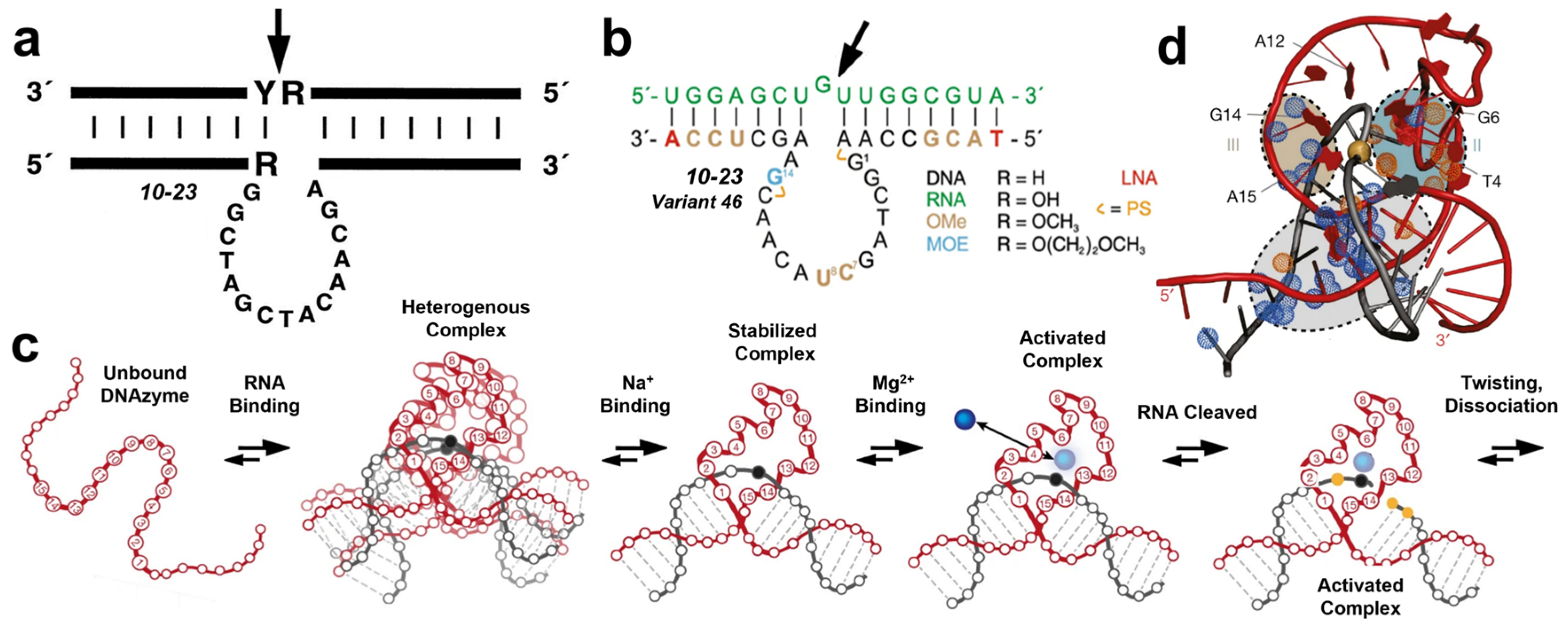

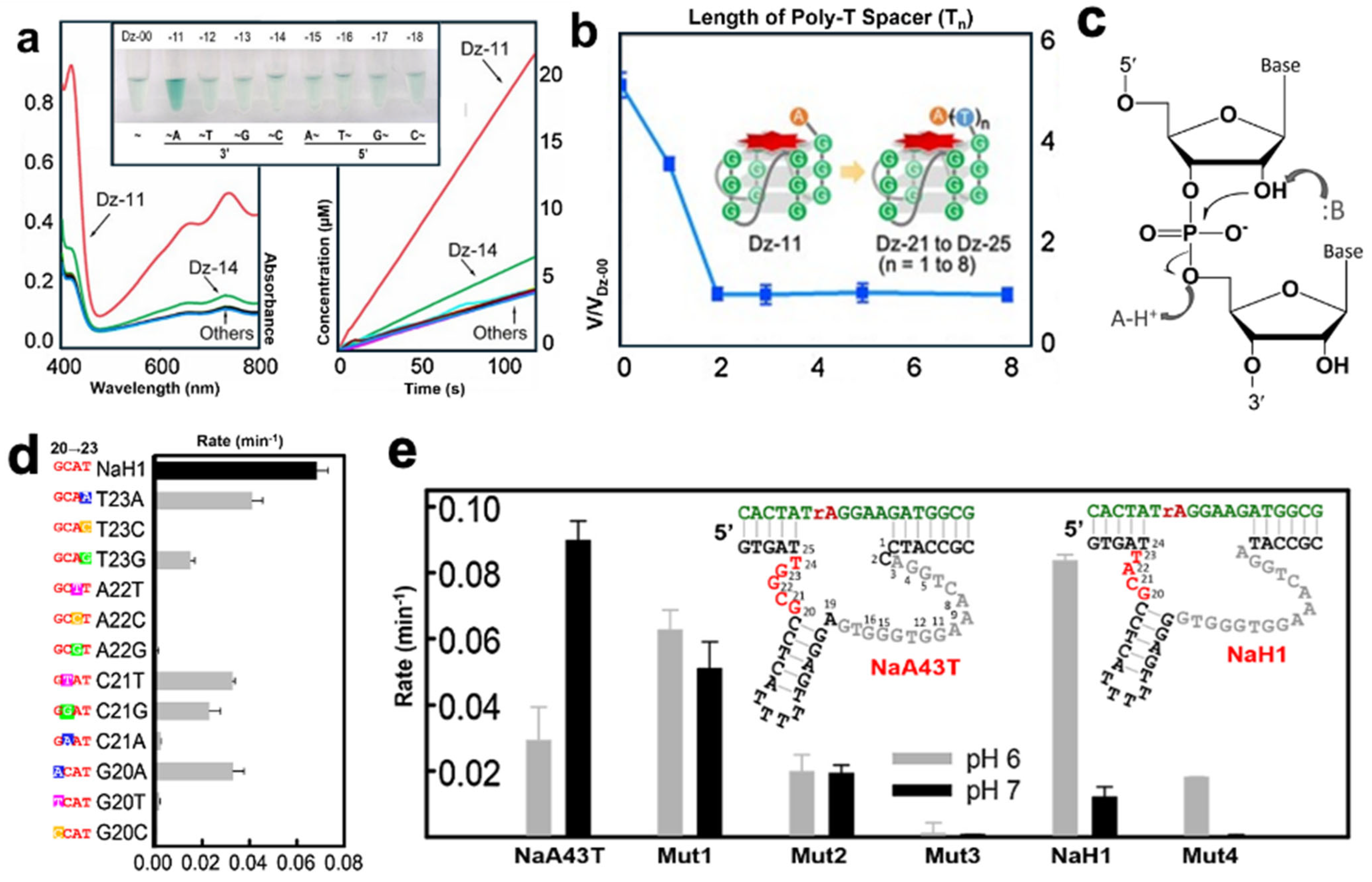
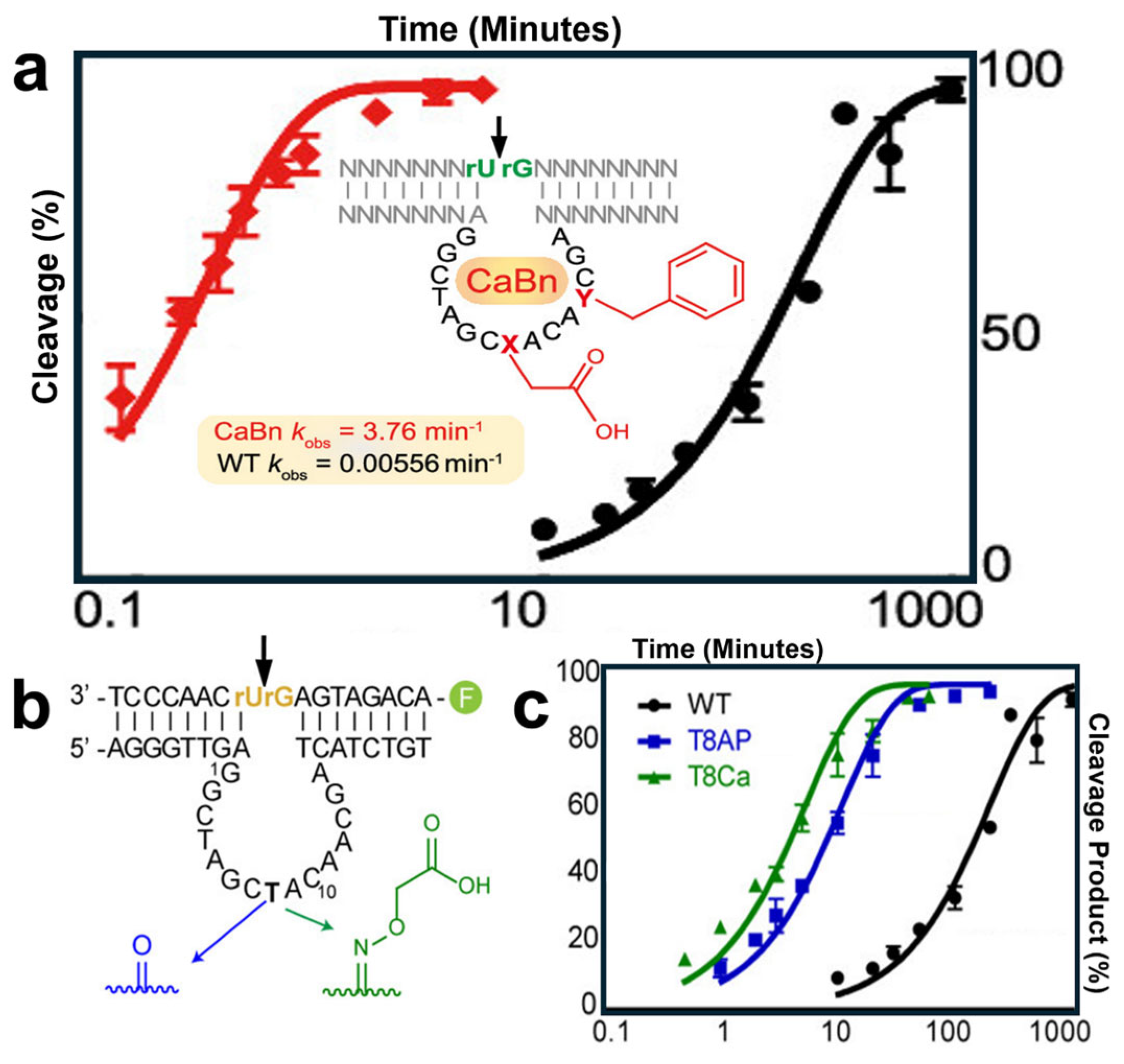
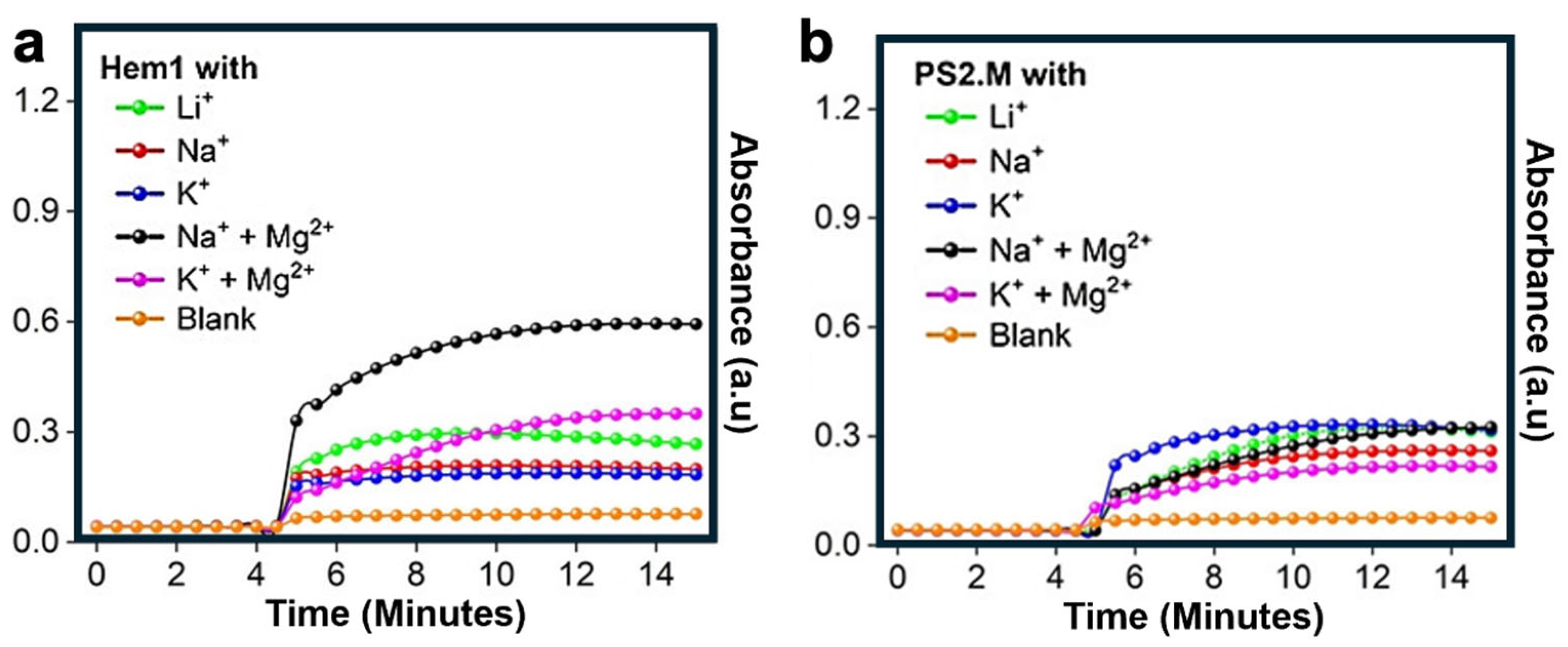

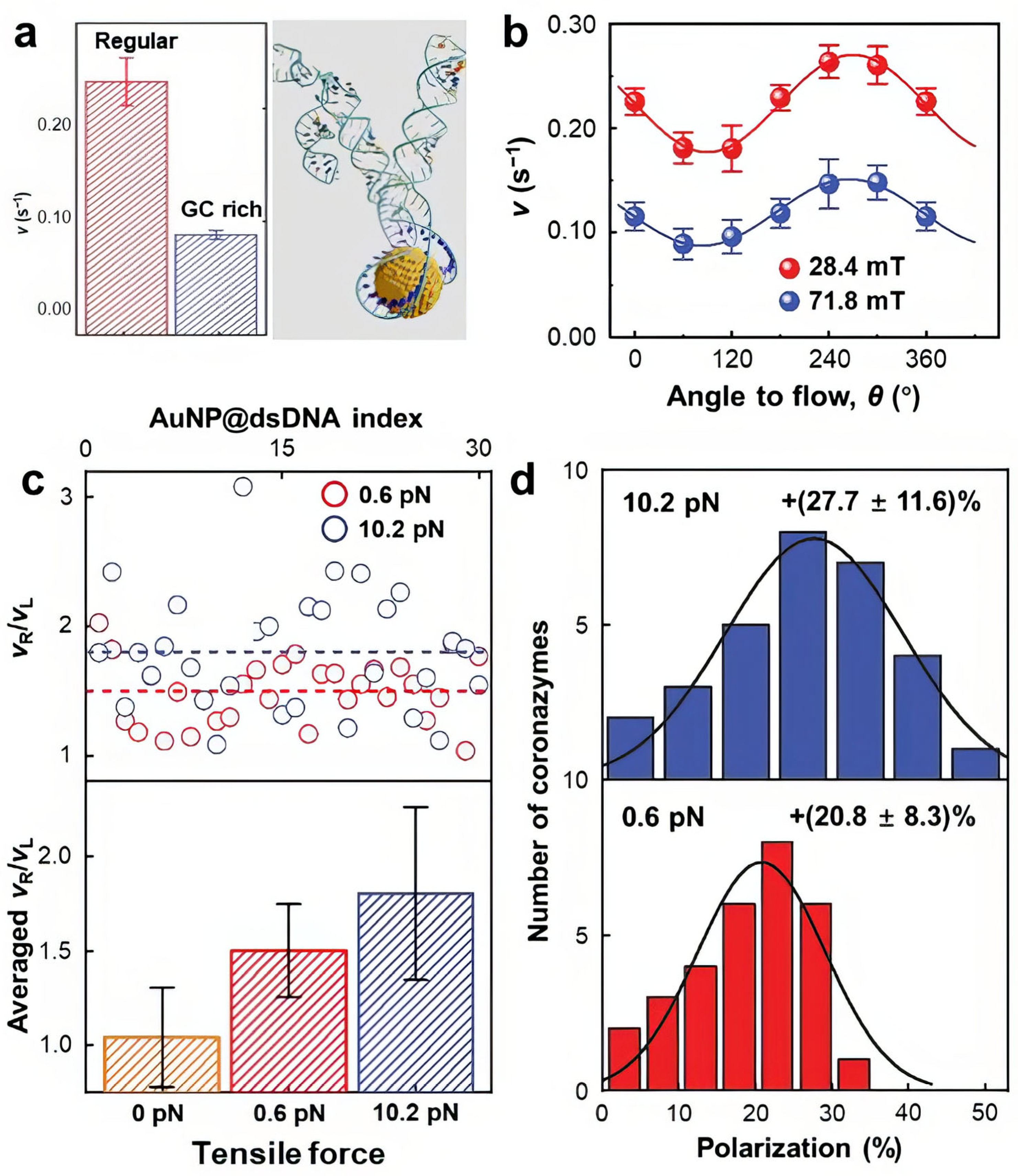
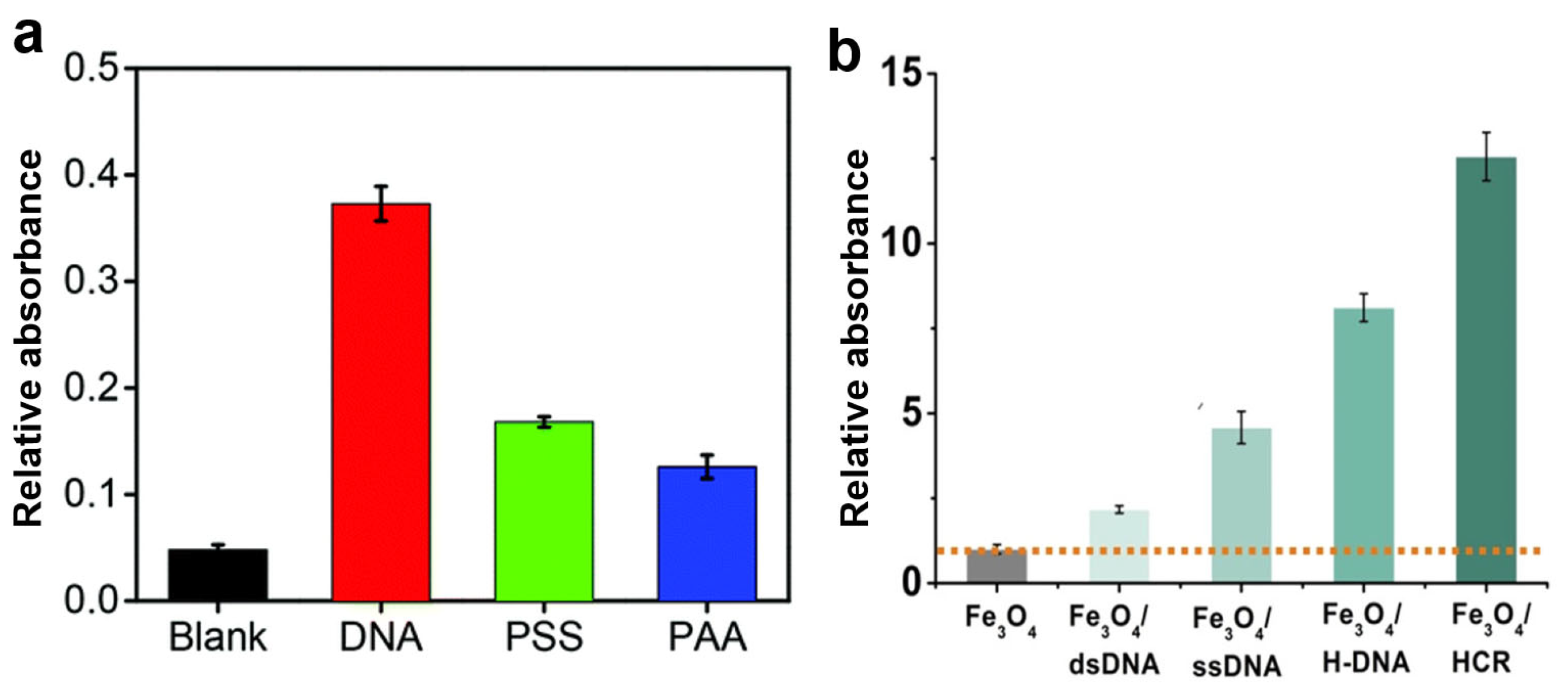

Disclaimer/Publisher’s Note: The statements, opinions and data contained in all publications are solely those of the individual author(s) and contributor(s) and not of MDPI and/or the editor(s). MDPI and/or the editor(s) disclaim responsibility for any injury to people or property resulting from any ideas, methods, instructions or products referred to in the content. |
© 2024 by the authors. Licensee MDPI, Basel, Switzerland. This article is an open access article distributed under the terms and conditions of the Creative Commons Attribution (CC BY) license (https://creativecommons.org/licenses/by/4.0/).
Share and Cite
Stratton, R.L.; Pokhrel, B.; Smith, B.; Adeyemi, A.; Dhakal, A.; Shen, H. DNA Catalysis: Design, Function, and Optimization. Molecules 2024, 29, 5011. https://doi.org/10.3390/molecules29215011
Stratton RL, Pokhrel B, Smith B, Adeyemi A, Dhakal A, Shen H. DNA Catalysis: Design, Function, and Optimization. Molecules. 2024; 29(21):5011. https://doi.org/10.3390/molecules29215011
Chicago/Turabian StyleStratton, Rebecca L., Bishal Pokhrel, Bryce Smith, Adeola Adeyemi, Ananta Dhakal, and Hao Shen. 2024. "DNA Catalysis: Design, Function, and Optimization" Molecules 29, no. 21: 5011. https://doi.org/10.3390/molecules29215011
APA StyleStratton, R. L., Pokhrel, B., Smith, B., Adeyemi, A., Dhakal, A., & Shen, H. (2024). DNA Catalysis: Design, Function, and Optimization. Molecules, 29(21), 5011. https://doi.org/10.3390/molecules29215011





